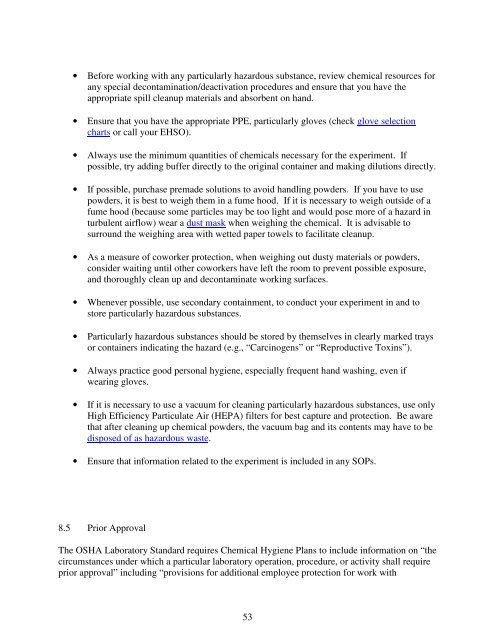Chemical Hygiene Plan - Queensborough Community College ...
Chemical Hygiene Plan - Queensborough Community College ...
Chemical Hygiene Plan - Queensborough Community College ...
Create successful ePaper yourself
Turn your PDF publications into a flip-book with our unique Google optimized e-Paper software.
• Before working with any particularly hazardous substance, review chemical resources for<br />
any special decontamination/deactivation procedures and ensure that you have the<br />
appropriate spill cleanup materials and absorbent on hand.<br />
• Ensure that you have the appropriate PPE, particularly gloves (check glove selection<br />
charts or call your EHSO).<br />
• Always use the minimum quantities of chemicals necessary for the experiment. If<br />
possible, try adding buffer directly to the original container and making dilutions directly.<br />
• If possible, purchase premade solutions to avoid handling powders. If you have to use<br />
powders, it is best to weigh them in a fume hood. If it is necessary to weigh outside of a<br />
fume hood (because some particles may be too light and would pose more of a hazard in<br />
turbulent airflow) wear a dust mask when weighing the chemical. It is advisable to<br />
surround the weighing area with wetted paper towels to facilitate cleanup.<br />
• As a measure of coworker protection, when weighing out dusty materials or powders,<br />
consider waiting until other coworkers have left the room to prevent possible exposure,<br />
and thoroughly clean up and decontaminate working surfaces.<br />
• Whenever possible, use secondary containment, to conduct your experiment in and to<br />
store particularly hazardous substances.<br />
• Particularly hazardous substances should be stored by themselves in clearly marked trays<br />
or containers indicating the hazard (e.g., “Carcinogens” or “Reproductive Toxins”).<br />
• Always practice good personal hygiene, especially frequent hand washing, even if<br />
wearing gloves.<br />
• If it is necessary to use a vacuum for cleaning particularly hazardous substances, use only<br />
High Efficiency Particulate Air (HEPA) filters for best capture and protection. Be aware<br />
that after cleaning up chemical powders, the vacuum bag and its contents may have to be<br />
disposed of as hazardous waste.<br />
• Ensure that information related to the experiment is included in any SOPs.<br />
8.5 Prior Approval<br />
The OSHA Laboratory Standard requires <strong>Chemical</strong> <strong>Hygiene</strong> <strong>Plan</strong>s to include information on “the<br />
circumstances under which a particular laboratory operation, procedure, or activity shall require<br />
prior approval” including “provisions for additional employee protection for work with<br />
53
















